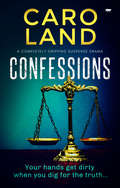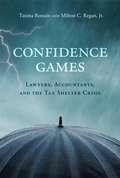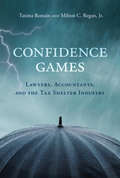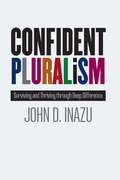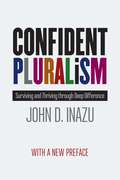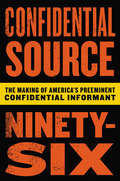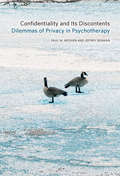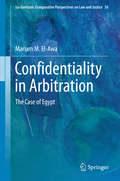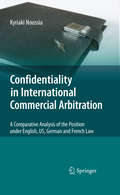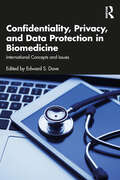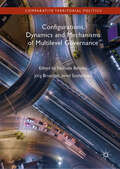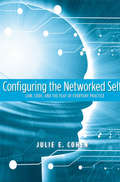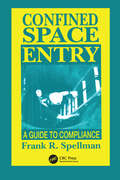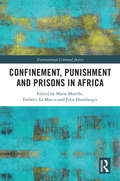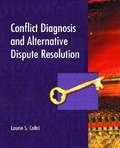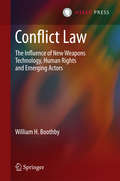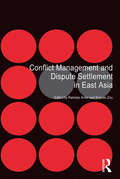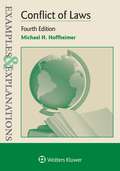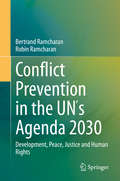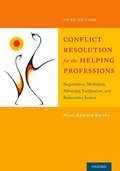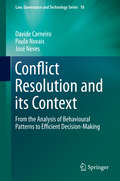- Table View
- List View
Confessions: A Completely Gripping Suspense Drama (The Natalie Bach Novels #2)
by Caro LandA brilliant new drama by bestselling author Caroline England, writing as Caro Land. Dig for the truth and you’ll get dirty… Natalie Bach is facing personal turmoil, legal conundrums and challenges. While trying to make a difference, she walks the fine line between being a help and a hinderance. Seconded to criminal law firm, Savage Solicitors, Nat finds herself out of her depth when she’s handed a complicated and tragic case of assisted suicide. Will she get to the bottom of what really happened? With a heavy workload to juggle, can Nat untangle her own feelings from another very personal and troubling investigation? What readers are saying about Confessions: 'Another magnificent tale starring solicitor, detective and lover, Natalie Bach. Warm, observational and compelling.’ Amanda Robson, bestselling author of Obsession 'I loved this book - fabulous, fun yet really gripping.’ C J Cooper, author of The Book Club Confessions is the second book in a gripping new legal, crime suspense series written by bestselling author Caroline England, writing as Caro Land, though can equally be read as an unmissable stand-alone. It will appeal to fans of authors like Diane Jeffrey, Samantha Hayes and K.L. Slater as well as readers of women's fiction.
Confidence Games
by Milton C. Regan Jr. Tanina RostainFor ten boom-powered years at the turn of the twenty-first century, some of America's most prominent law and accounting firms created and marketed products that enabled the very rich -- including newly minted dot-com millionaires -- to avoid paying their fair share of taxes by claiming benefits not recognized by law. These abusive domestic tax shelters bore such exotic names as BOSS, BLIPS, and COBRA and were developed by such prestigious firms as KPMG and Ernst & Young. They brought in hundreds of millions of dollars in fees from clients and bilked the U.S. Treasury of billions in revenues before the IRS and Justice Department stepped in with civil penalties and criminal prosecutions. In Confidence Games, Tanina Rostain and Milton Regan describe the rise and fall of the tax shelter industry during this period, offering a riveting account of the most serious episode of professional misconduct in the history of the American bar. Rostain and Regan describe a beleaguered IRS preoccupied by attacks from antitax and antigovernment politicians; heightened competition for professional services; the relaxation of tax practitioner norms against aggressive advice; and the creation of complex financial instruments that made abusive shelters harder to detect. By 2004, the tax shelter boom was over, leaving failed firms, disgraced professionals, and prison sentences in its wake. Rostain and Regan's cautionary tale remains highly relevant today, as lawyers and accountants continue to face intense competitive pressure and regulators still struggle to keep pace with accelerating financial risk and innovation.
Confidence Games: Lawyers, Accountants, and the Tax Shelter Industry (The\mit Press Ser.)
by Tanina Rostain Milton C. ReganThe rise and fall of a tax shelter industry that enabled some of America's richest citizens to avoid paying their fair share of taxes.For ten boom-powered years at the turn of the twenty-first century, some of America's most prominent law and accounting firms created and marketed products that enabled the very rich—including newly minted dot-com millionaires—to avoid paying their fair share of taxes by claiming benefits not recognized by law. These abusive domestic tax shelters bore such exotic names as BOSS, BLIPS, and COBRA and were developed by such prestigious firms as KPMG and Ernst & Young. They brought in hundreds of millions of dollars in fees from clients and bilked the U.S. Treasury of billions in revenues before the IRS and Justice Department stepped in with civil penalties and criminal prosecutions. In Confidence Games, Tanina Rostain and Milton Regan describe the rise and fall of the tax shelter industry during this period, offering a riveting account of the most serious episode of professional misconduct in the history of the American bar.Rostain and Regan describe a beleaguered IRS preoccupied by attacks from antitax and antigovernment politicians; heightened competition for professional services; the relaxation of tax practitioner norms against aggressive advice; and the creation of complex financial instruments that made abusive shelters harder to detect. By 2004, the tax shelter boom was over, leaving failed firms, disgraced professionals, and prison sentences in its wake. Rostain and Regan's cautionary tale remains highly relevant today, as lawyers and accountants continue to face intense competitive pressure and regulators still struggle to keep pace with accelerating financial risk and innovation.
Confident Pluralism: Surviving and Thriving through Deep Difference
by John D. InazuIn recent years, the United States has become increasingly polarized and divided. This fissure is evident across the nation in conflict over LGBTQ rights; in challenges to religious liberty; in clashes over abortion; in tensions between law enforcement and minority communities. With all of this physical and emotional violence enacted by our legal system and such seemingly irresolvable differences in beliefs, values, and identities across the country, we are forced to ask--how can the people of this nation ever live in peace together? In Confident Pluralism, John D. Inazu analyzes the current state of the country, orients the contemporary United States within its broader history, and explores the ways that Americans can--and must--live together peaceably despite these deeply engrained differences. Pluralism is one of the founding creeds of the United States--yet America's society and legal system continues to face deep, unsolved structural problems in dealing with differing cultural anxieties, and minority viewpoints. Inazu not only argues that it is possible to cohabitate peacefully in this country, but also lays out realistic guidelines for our society and legal system to achieve the new American dream through civic practices that value toleration over protest, humility over defensiveness, and persuasion over coercion. An essential clarion call during one of the most troubled times in US history, Confident Pluralism offers a refreshing argument for how the legal system can protect peoples' personal beliefs and differences and shows how we can build toward a healthier future of tolerance, patience, and empathy.
Confident Pluralism: Surviving and Thriving through Deep Difference
by John D. InazuIn the three years since Donald Trump first announced his plans to run for president, the United States seems to become more dramatically polarized and divided with each passing month. There are seemingly irresolvable differences in the beliefs, values, and identities of citizens across the country that too often play out in our legal system in clashes on a range of topics such as the tensions between law enforcement and minority communities. How can we possibly argue for civic aspirations like tolerance, humility, and patience in our current moment? In Confident Pluralism, John D. Inazu analyzes the current state of the country, orients the contemporary United States within its broader history, and explores the ways that Americans can—and must—strive to live together peaceably despite our deeply engrained differences. Pluralism is one of the founding creeds of the United States—yet America’s society and legal system continues to face deep, unsolved structural problems in dealing with differing cultural anxieties and differing viewpoints. Inazu not only argues that it is possible to cohabitate peacefully in this country, but also lays out realistic guidelines for our society and legal system to achieve the new American dream through civic practices that value toleration over protest, humility over defensiveness, and persuasion over coercion. With a new preface that addresses the election of Donald Trump, the decline in civic discourse after the election, the Nazi march in Charlottesville, and more, this new edition of Confident Pluralism is an essential clarion call during one of the most troubled times in US history. Inazu argues for institutions that can work to bring people together as well as political institutions that will defend the unprotected. Confident Pluralism offers a refreshing argument for how the legal system can protect peoples’ personal beliefs and differences and provides a path forward to a healthier future of tolerance, humility, and patience.
Confidential Source Ninety-Six: The Making Of America's Preeminent Confidential Informant
by C. S. 96A HARROWING JOURNEY INSIDE THE HIDDEN WORLD OF DRUG CARTELS BY ONE OF THE TOP CRIMINAL INFORMANTS IN U.S. LAW ENFORCEMENT HISTORY.The men he put behind bars know him as Roman Caribe or one of the dozens of other aliases he has used undercover. His handlers in the DEA, ICE, and FBI know him as Confidential Source Ninety-Six, or C.S. 96, named for the year he confronted the sins of his life atop a massive drug distribution ring and flipped, becoming law enforcement's secret weapon. In Confidential Source Ninety-Six, Caribe tells the extraordinary story of his transformation into America's most successful informant in terms of total narcotics seized--from the years of trafficking cocaine and marijuana across the U.S. for a terrifying drug lord, eventually becoming that man's number two, to his decision to defect and trade sides. In his first mission, Caribe set his sights on his onetime boss's brutal operation. In his next, he broke all protocol and made a daring foray into the notorious Fuentes Cartel, where he took down a family that was smuggling tons of drugs across the U.S.-Mexico border.As Caribe launched his career as a confidential source, finding his faith and seeking to finally do right by his stoic wife, Inez, and his four children, his marriage became stressed in new ways, the risks to his family unimaginable if he made a single mistake on the job. He found himself looking over his shoulder every day, knowing that with each drug ring or kingpin he destroyed, he made another dangerous enemy. For as long as he continued the high stakes work, he would survive on the cunning of his tradecraft and his ability to improvise in the most terrifying circumstances. Unfolding in Southern California mansions, makeshift DEA trailers deep in the redwood forest, drug fronts in Spanish Harlem, fast-food parking lots where kilograms of cocaine and heroin change hands, and around the dinner table where Caribe began mentoring at-risk youth to help them avoid the mistakes he made, Confidential Source Ninety-Six is the epic saga of one man's quest to redeem himself and a thrilling look at the law enforcement battle that rages in the shadows of our nation.
Confidentiality and Its Discontents: Dilemmas of Privacy in Psychotherapy (Psychoanalytic Interventions)
by Paul W. Mosher Jeffrey BermanFreud promised his patients absolute confidentiality, regardless of what they revealed, but privacy in psychotherapy began to erode a half-century ago. Psychotherapists now seem to serve as “double agents” with a dual and often conflicting allegiance to patient and society. Some therapists even go so far as to issue Miranda-type warnings, advising patients that what they say in therapy may be used against them.Confidentiality and Its Discontents explores the human stories arising from this loss of confidentiality in psychotherapy. Addressing different types of psychotherapy breaches, Mosher and Berman begin with the the story of novelist Philip Roth, who was horrified when he learned that his psychoanalyst had written a thinly veiled case study about him. Other breaches of privacy occur when the so-called duty to protect compels a therapist to break confidentiality by contacting the police. Every psychotherapist has heard about “Tarasoff,” but few know the details of this story of fatal attraction. Nor are most readers familiar with the Jaffee case, which established psychotherapist-patient privilege in the federal courts. Similiarly, the story of Robert Bierenbaum, a New York surgeon who was brought to justice fifteen years after he brutally murdered his wife, reveals how privileged communication became established in a state court. Meanwhile, the story of New York Chief Judge Sol Wachtler, convicted of harassing a former lover and her daughter, shows how the fear of the loss of confidentiality may prevent a person from seeking treatment, with potentially disastrous results.While affirming the importance of the psychotherapist-patient privilege, Confidentiality and Its Discontents focuses on both the inner and outer stories of the characters involved in noteworthy psychotherapy breaches and the ways in which psychiatry and the law can complement but sometimes clash with each other.
Confidentiality in Arbitration: The Case of Egypt (Ius Gentium: Comparative Perspectives on Law and Justice #56)
by Mariam M. M. El-AwaThis book addresses the issue of privacy and confidentiality in the broader context of the Egyptian legal system. The volume opens with an overview of the major approaches to confidentiality adopted in various jurisdictions. It goes on to examine the duties of confidentiality and privacy in arbitration law and practice on the basis of interviews with 30 law professors and practitioners who often act as arbitrators or counsel for parties in arbitral disputes together with the relevant Egyptian arbitration law provisions. The book takes into account the relevant provisions in the arbitration laws of Syria, Saudia Arabia and Yemen. It moves on to explore the relation between arbitration and the judicial system, and the extent to which the former should borrow its rules from the latter with regard to publicity and the rule of public trial. Finally, this book looks at the right to privacy as (a) a constitutional right, as a potential basis for a legal duty of confidentiality in arbitration, and the duties stemming from this constitutional right in the various laws of Egypt, as well as (b) the constraints imposed on the right to privacy, in particular those stemming from the constitutional principles of freedom of speech and freedom of the press. The main conclusion is that confidentiality does indeed exist in arbitration. However, its legal basis is not the law on arbitration or the arbitration agreement. It is in fact a corollary of the fundamental right to privacy granted in the Egyptian legal system to both natural and legal persons.
Confidentiality in International Commercial Arbitration: A Comparative Analysis of the Position under English, US, German and French Law
by Kyriaki NoussiaArbitration is an essential component in business. In an age when transparency is a maxim, important issues which the laws governing arbitration currently fail to address are the extent to which disclosure of information can be constrained by private agreement along with the extent to which the duty to preserve confidentiality can be stretched. Absent a coherent legal framework and extensive qualitative and quantitative data, it is equally difficult to suggest and predict future directions. This book offers a tool for attaining centralised access to otherwise fragmentary and dispersed material, as well as a comprehensive analysis and detailed exposition of the position in relation to confidentiality in arbitration in the jurisdictions of England, USA, France and Germany.
Confidentiality, Privacy, and Data Protection in Biomedicine: International Concepts and Issues
by Edward S. DoveFeaturing contributions from leading scholars of health privacy law, this important volume offers insightful reflection on issues such as confidentiality, privacy, and data protection, as well as analysis in how a range of jurisdictions—including the US, the UK, Europe, South Africa, and Australia—navigate a rapidly developing biomedical environment.While the collection of personal health information offers the potential to drive research and innovation, it also generates complex legal and ethical questions in how this information is used to ensure the rights and interests of individuals and communities are respected. But in many ways laws have struggled to keep pace with technological developments. This book therefore seeks to fill a lacuna for legal insight and reflection. Over three parts, the book first explores the conceptual landscape which law and legal institutions must contend, and then turns to examine practical issues such as the GDPR, secondary use of data for research, genomic research, and data trusts.With cutting-edge analysis drawing on domestic and international case law, legislation, and policy, this comprehensive volume will prove fascinating reading for all students and researchers interested in this evolving and contentious area of study.
Configurations, Dynamics and Mechanisms of Multilevel Governance (Comparative Territorial Politics)
by Jared Sonnicksen Nathalie Behnke Jörg BroschekThis edited volume provides a comprehensive overview of the diverse and multi-faceted research on governance in multilevel systems. The book features a collection of cutting-edge trans-Atlantic contributions, covering topics such as federalism, decentralization as well as various forms and processes of regionalization and Europeanization. While the field of multilevel governance is comparatively young, research in the subject has also come of age as considerable theoretical, conceptual and empirical advances have been achieved since the first influential works were published in the early noughties. The present volume aims to gauge the state-of-the-art in the different research areas as it brings together a selection of original contributions that are united by a variety of configurations, dynamics and mechanisms related to governing in multilevel systems.
Configuring the Networked Self
by Julie E. CohenThe legal and technical rules governing flows of information are out of balance, argues Julie E. Cohen in this original analysis of information law and policy. Flows of cultural and technical information are overly restricted, while flows of personal information often are not restricted at all. The author investigates the institutional forces shaping the emerging information society and the contradictions between those forces and the ways that people use information and information technologies in their everyday lives. She then proposes legal principles to ensure that people have ample room for cultural and material participation as well as greater control over the boundary conditions that govern flows of information to, from, and about them.
Confined Space Entry: Guide to Compliance
by Frank R. SpellmanFROM THE PREFACEThis book brings together (in one text) all of the Occupational Safety and Health Administration's regulatory requirements for making safe and proper confined space entries. Because confined space entry is a complicated procedure-and a process that contains inherent risks-those concerned with safety in the work place are constan
Confinement, Punishment and Prisons in Africa (Transnational Criminal Justice)
by Marie Morelle, Frédéric Le Marcis and Julia HornbergerThis interdisciplinary volume presents a nuanced critique of the prison experience in diverse detention facilities across Africa. The book stresses the contingent, porous nature of African prisons, across both time and space. It draws on original long-term ethnographic research undertaken in both Francophone and Anglophone settings, which are grouped in four parts. The first part examines how the prison has imprinted itself on wider political and social imaginaries and, in turn, how structures of imprisonment carry the imprint of political action of various times. The second part stresses how particular forms of ordering emerge in African prisons. It is held that while these often involve coercion and neglect, they are better understood as the product of on-going negotiations and the search for meaning and value on the part of a multitude of actors. The third part is concerned with how prison life percolates beyond its physical perimeters into its urban and rural surroundings, and vice versa. It deals with the popular and contested nature of what prisons are about and what they do, especially in regard to bringing about moral subjects. The fourth and final part of the book examines how efforts of reforming and resisting the prison take shape at the intersection of globally circulating models of good governance and levels of self-organisation by prisoners. The book will be an essential reference for students, academics and policy-makers in Law, Criminology, Sociology and Politics.
Confirming Justice—Or Injustice?: A Guide to Judging RBG's Successor
by Alan DershowitzIn Confirming Justice—Or Injustice?, Alan Dershowitz—New York Times bestselling author and one of America&’s most respected legal scholars—contemplates the past, present, and future of the Supreme Court, from the death of Ruth Bader Ginsburg to the confirmation battle looming over President Trump&’s nomination of Judge Amy Coney Barrett. Alan Dershowitz has been called &“one of the most prominent and consistent defenders of civil liberties in America&” by Politico and &“the nation&’s most peripatetic civil liberties lawyer and one of its most distinguished defenders of individual rights&” by Newsweek. He is also a fair-minded and even-handed expert on the Constitution and American government, and in this book offers his knowledge and insight to help readers understand the current circumstances surrounding the Supreme Court and the looming partisan battle for its future. Confirming Justice—Or Injustice? is an analysis of every aspect of the possible confirmation of Judge Amy Coney Barrett to fill the vacant seat left by the death of Ruth Bader Ginsburg. It includes timely commentary on the history and process of confirming justices to the Supreme Court, notes about what might happen if the process is changed—such as by court packing or instituting age or term limits for justices—and discussion of the roles of the various people and groups who might have input on the confirmation, from the president to the senate to the judiciary committee to the Constitution itself. In the end, Confirming Justice—Or Injustice? represents an icon in American law and politics reckoning with an increasingly politicized and polarized nomination-and-confirmation process for judges and what those shifts might mean for the country, both now and in days to come. It is essential reading for anyone interested in or concerned about Trump's nomination of Amy Coney Barrett and the process of her possible confirmation, the legacy of Ruth Bader Ginsburg, and the future and fate of the Supreme Court—and American democracy itself.
Conflict Diagnosis And Alternative Dispute Resolution
by Laurie ColtriFilling a void in the market,Conflict Diagnosis, Brief Editionuses the innovation of the Conflict Diagnosis concept to provide an in-depth appreciation of ADR processes. The survey takes both a true sociological perspective on the interdisciplinary topic of alternative disputes and prefaces these descriptions with an in-depth exploration of the theoretical and empirical basis for understanding their uses, misuses, indications and counterindications to provide readers with a thorough and complete approach to understanding, evaluating and developing strategies and tactics to address interpersonal conflict.The survey addresses basic definitions, dispute resolution processes, preconceptions about conflict and how they short change us, conflict diagnosis, the nine steps of conflict diagnosis, alternative dispute resolution processes, using conflict diagnosis to manage legal disputes and select ADR processes.For human resources personnel, dispute resolution system designers, trainers and ombuds, as well as ADR neutrals and neutrals-in-training.
Conflict Displacement and Legal Protection: Understanding Asylum, Human Rights and Refugee Law (Law and Migration)
by Charlotte LülfWhile the 21st century bears witness to several conflicts leading to mass displacement, the conflict in Syria has crystallised the need for a solid legal framework and legal certainty. This book analyses the relevant legal instruments for the provision of a protection status for persons fleeing to Europe from conflict and violence. It focuses on the conceptualisation of conflict and violence in the countries of origin and the different approaches taken in the interpretation of them in the 1951 Refugee Convention, the Recast Qualification Directive of the European Union and the European Convention on Human Rights. It traces the hierarchical order of protection granted, starting with refugee protection status, to subsidiary protection status and finally with the negative protection from non-refoulement. Recent case law and asylum status determination practices of European countries illustrate the obstacles in the interpretation as well as the divergence in the application of the legal instruments. The book fills an important gap in examining the current practices of key actors, including the United Nations High Commissioner for Refugees and European states, tracing changes in national and international policies and revealing discrepancies towards contemporary approaches to conflicts. It refines the interaction and cross-fertilisation of the different relevant fields of European asylum law, human rights law and the laws of armed conflict in order to further the development of a harmonised protection regime for conflict-induced displacement.
Conflict Law: The Influence of New Weapons Technology, Human Rights and Emerging Actors
by William H. BoothbyTopics as diverse as the evolving spectrum of conflict, innovations in weaponry, automated and autonomous attack, the depersonalisation of warfare, detention operations, the influence of modern media and the application of human rights law to the conduct of hostilities are examined in this book to see to what extent existing legal norms are challenged. The book takes each topic in turn, explains relevant provisions of contemporary law and analyses exactly where the legal problem lies. The analysis then develops the theme, examining for example the implications of current rules as to deception operations for certain applications of cyber warfare. The text is written in an accessible style, and demonstrates the continuing relevance of established rules and the importance of compliance with them. Useful for academics, military, governments, ministries of defence, ministries of foreign affairs, libraries, diplomats, think tanks, policy units, NGOs, and all others with an interest in law of armed conflict issues such as journalists and students.
Conflict Management and Dispute Settlement in East Asia
by Ramses AmerThrough a multi-disciplinary approach, this volume studies the management and settlement of conflict and disputes in East Asia. Conflict and disputes exist everywhere in human society. The management and settlement of them has become an imperative. This volume is a significant contribution to a broader understanding of the complexities involved in managing and settling disputes and conflicts at regional, inter-state and intra-state levels in the East Asian region. Drawing on expertise in Peace and Conflict, International Relations, and International Law the volume presents to the reader a general picture of how conflict can be managed at the international and regional levels through various mechanisms, in particular, through prominent regional organizations such as ASEAN. It then moves on to case studies at the regional level including inter-state and intra-state conflicts and disputes. The last part of the volume highlights how states resolve their maritime disputes. This has drawn much attention from the international community due to various factors such as the increasing demand for natural resources from the oceans. These disputes disrupt the smooth development of international relations as well as trigger tensions and confrontation between states.
Conflict Of Laws (Examples And Explanations)
by Michael H. HoffheimerA favorite among successful students, and often recommended by professors, the unique Examples & Explanations series gives you extremely clear introductions to concepts followed by realistic examples that mirror those presented in the classroom throughout the semester. Use at the beginning and midway through the semester to deepen your understanding through clear explanations, corresponding hypothetical fact patterns, and analysis. Then use to study for finals by reviewing the hypotheticals as well as the structure and reasoning behind the accompanying analysis. Designed to complement your casebook, the trusted Examples & Explanations titles get right to the point in a conversational, often humorous style that helps you learn the material each step of the way and prepare for the exam at the end of the course. Clear, informal, and even humorous, Examples & Explanations: Conflicts of Law, 3E, explores all of the topics covered in Conflicts courses, including personal jurisdiction and the Erie doctrine. It provides full treatment of traditional and modern approaches to choice of law and proof of law, with up-to-date coverage of constitutional limits. Big-picture overviews and accurate statement rules are reinforced with concrete examples and test-taking tips. The powerful Examples & Explanations pedagogy works especially well for Conflict of Laws where students gain understanding of rules and policies by applying them to new fact patterns. Summaries of leading cases found in most casebooks and a modular organization allows easy adaptation to any course. The Third Edition adds new Supreme Court decisions, provides a new chapter on transfers and forum non conveniens, and adds coverage of the new European Union rules on inheritance and wills.
Conflict Of Laws: American, Comparative, International Cases And Materials (American Casebook)
by Symeon C. SymeonidesThis versatile and pedagogically effective book brings together in a coordinated way the rich and diverse perspectives and 80 years combined teaching experience of two highly respected conflicts scholars: the author of 30 annual surveys of choice-of-law cases and drafter of three conflicts codifications, and the author of a path-breaking, established casebook on civil procedure. The book presents the real world of conflict law, behind the leading cases and beyond America's borders, through distilled documentation of what courts actually do and strategically placed extensive information about international practice and the law of other countries.
Conflict Prevention in the UN´s Agenda 2030: Development, Peace, Justice and Human Rights
by Robin Ramcharan Bertrand RamcharanThis book analyses the UN’s Agenda 2030 and reveals that progress is lagging on all five interlocking and interdependent themes that are discussed: conflict prevention, development, peace, justice and human rights. Many voices have already been raised, including that of the UN Secretary-General that the Sustainable Development Goals will not be met by 2030 unless there is a re-doubling of efforts. Still, on development as such, there is much striving. The book puts the concept of preventive diplomacy into all of the issues of modern international relations, from the US/China confrontation to the various conflicts bedeviling Africa. It bridges the two worlds of the international relations specialist on the one hand and that of the academic interested in UN affairs on the other hand. There is normally little contact between those two specializations. The authors have taken several current issues to show how the millennium debates and the SDG targets are relevant to "realist school" conflicts, and that there is work under way to operationalize ideas and theories in this respect. This is the first ever discussion of the conflict prevention dimension in the UN’s Agenda 2030 which seeks to advance sustainable development with a view to reinforcing peace and justice on the foundations of respect for universal human rights.
Conflict Refugees: European Union Law and Practice (Cambridge Asylum and Migration Studies)
by Christel QuertonBased on a systematic and empirical comparative study of six European Union countries, Christel Querton explores judicial decision-making in the context of persons fleeing armed conflicts in the EU. Addressing and redressing misconceptions about the relevance of the Refugee Convention, this book demonstrates how appellate authorities across the EU approach situations of armed conflict predominantly through outdated understandings of warfare and territoriality. Thus, they apply a higher standard of proof than is warranted by international refugee law. Adopting a gender perspective, Querton also shows how appellate authorities fail to acknowledge the gender-differentiated impact of armed conflicts. Drawing from gender and security studies, this book proposes an original conceptual framework which, supported by existing international legal standards, reframes the definition of 'refugee' and better reflects the reality of violence in modern-day conflicts. In doing so, it re-asserts the Refugee Convention as the cornerstone of international protection.
Conflict Resolution For The Helping Professions: Negotiation, Mediation, Advocacy, Facilitation, and Restorative Justice
by Allan Edward BarskyWhen people think of conflict, they often think of fights, wars, arguments, hot tempers, and hurtful consequences. This book provides helping professionals with the theory, strategies, and skills they need to deal with conflict in a manner that is respectful, collaborative, and constructive. This text illustrates how helping professionals can incorporate evidence-based models of conflict resolution to work more effectively and enjoyably with clients, coworkers, supervisors, and others. Practitioners will learn how to respond effectively when others use power, positions, and competition. Whereas many conflict resolution texts focus on one method or approach to practice, this textbook provides practitioners with various models that they can incorporate in their roles as negotiators, counselors, mediators, facilitators, advocates, and peacebuilders.
Conflict Resolution and its Context: From the Analysis of Behavioural Patterns to Efficient Decision-Making (Law, Governance and Technology Series #18)
by Davide Carneiro Paulo Novais José NevesThis book studies how technological solutions can be used to alleviate the current state of legal systems, with their clogged up courtrooms and inefficient conflict resolution methods. It reviews the shortcomings and disadvantages of traditional and alternative conflict resolution methods and turns to Artificial Intelligence for problem-solving techniques and solutions. The book is divided into four parts. The first part presents a general and systematic analysis of the current state of the legal systems, identifying the main problems and their causes It then moves on to present UM Court: a framework for testing and prototyping conflict resolution services. This framework was developed with the objective of using Artificial Intelligence techniques to build a service environment for conflict resolution. The third part of the book takes a step into the future by analyzing the use of Intelligent Environments in the support of conflict management and resolution. It describes the approach taken and the experiments performed in the Intelligent Systems Lab of the University of Minho. The final part of the book contains the conclusions and shows the potential advantages of the use of Intelligent Environments as a way to implement better conflict resolution procedures (virtual or real), in which all the participants have access to more and better information and are able to take better informed decisions.
